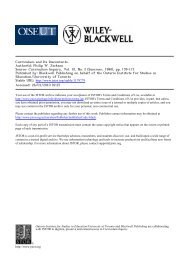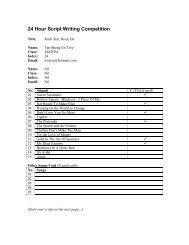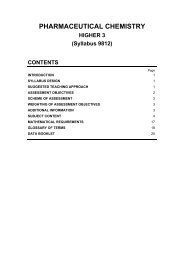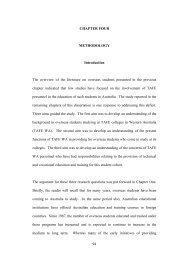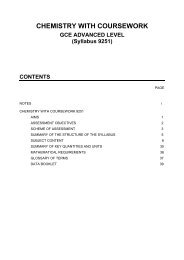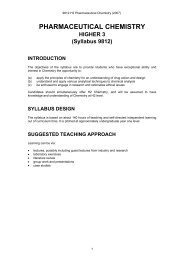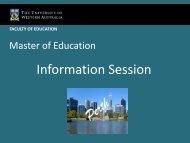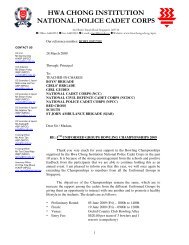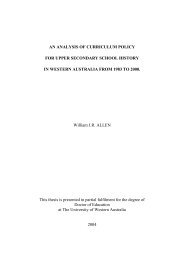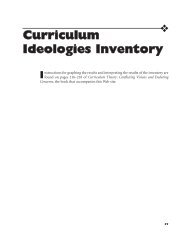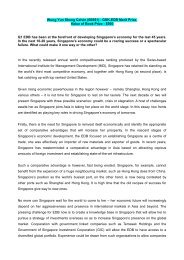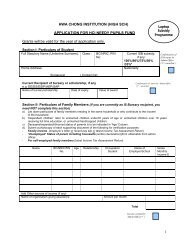Hwa Chong Model ASEAN Summit
Hwa Chong Model ASEAN Summit
Hwa Chong Model ASEAN Summit
Create successful ePaper yourself
Turn your PDF publications into a flip-book with our unique Google optimized e-Paper software.
<strong>Hwa</strong> <strong>Chong</strong> <strong>Model</strong> <strong>ASEAN</strong> <strong>Summit</strong><br />
7 March 2011 – 11 March 2011<br />
Delegate’s Handbook<br />
<strong>Hwa</strong> <strong>Chong</strong> <strong>Model</strong> <strong>ASEAN</strong> <strong>Summit</strong> Participants<br />
9 th <strong>Model</strong> <strong>ASEAN</strong> <strong>Summit</strong> Pg 1 / 18
Introduction to <strong>ASEAN</strong><br />
Extracted from <strong>Hwa</strong> <strong>Chong</strong> <strong>Model</strong> <strong>ASEAN</strong> <strong>Summit</strong> Concept Paper. 2006.<br />
Today, <strong>ASEAN</strong> is not only a well-functioning, indispensable reality in the region. It is a real<br />
force to be reckoned with far beyond the region. It is also a trusted partner of the United<br />
Nations in the field of development…"<br />
Kofi Annan<br />
Secretary-General of the United Nations<br />
16 February 2000<br />
(Taken from the <strong>ASEAN</strong> Secretariat web site, 2006)<br />
In his book, “Can Asians Think”, Kishore Mahbubani referred to the Association of South East<br />
Asian Nations (<strong>ASEAN</strong>) as “one of the most underrated organizations of contemporary times”<br />
(Mahbubani, 1998, pg. 157). Its unique role in strengthening the consolidated position of<br />
Southeast Asian countries has often been neglected.<br />
Since the conclusion of World War 2, Southeast Asia has been described by regional experts as<br />
the “Balkans” of Asia – a region of diverse race, religion, language, culture, history and<br />
geography, according to former Singapore Ambassador to the UN, Kishore Mahbubani<br />
(Mahbubani, 2005, pg. 208).<br />
Founded in 1967 by five original Member Countries in Bangkok; Indonesia, Malaysia, Philippines,<br />
Singapore and Thailand, <strong>ASEAN</strong> has since grown to incorporate a total of 10 South East Asian<br />
nations. Against the backdrop of communist insurgency and the need to accelerate “economic<br />
growth, social progress and cultural development”, <strong>ASEAN</strong> was born. However, <strong>ASEAN</strong> was<br />
bound by a common need for “stability and growth to counter and deny the communists the<br />
social and economic conditions for revolution” (Lee, 2000, pg. 369). It took ten years before<br />
<strong>ASEAN</strong> developed cohesion and direction in its activities, built upon an organization which<br />
worked upon the principles of no interference, but took into consideration the interests of<br />
others, as mentioned by Minister Mentor Lee Kuan Yew in his memoirs, From Third World to<br />
First (Lee, 2000, pg. 370).<br />
This concept was further reiterated by Kishore Mahbubani; he opined that in the crucial early<br />
years, “all members realized that <strong>ASEAN</strong> could not succeed if any of its members tried to<br />
dominate the proceedings…each would have to be sensitive to the interests of others”. The<br />
seeds for future success as a regional body by developing consensus were thus sown. Moreover,<br />
9 th <strong>Model</strong> <strong>ASEAN</strong> <strong>Summit</strong> Pg 2 / 18
when consensus was not achieved, countries tried to settle for a compromise or a promise of<br />
cooperation (Lee, 2000, pg. 372). As of today, the <strong>ASEAN</strong> system of consensus has “generated<br />
mutual trust and comfort” amongst its Member Countries, more so than any other organisation<br />
(Mahbubani, 1998, pg. 159-160).<br />
<strong>ASEAN</strong> solidarity has been put to the test on various occasions, most notably during the<br />
Vietnamese occupation of Cambodia from 1978 to 1991 and it was spearheaded by the efforts<br />
of the late former Minister for Foreign Affairs, Mr. S. Rajaratnam. It involved striking a balance<br />
between maintaining the unity of <strong>ASEAN</strong> by opposing the interests and policies of Thailand and<br />
Indonesia while being successful in the isolation of Vietnam at the UN and international<br />
gatherings, as recounted by Minister Mentor Lee (Lee, 2000, pg. 374). This best illustrates the<br />
intricate balance between persevering and regional consensus while maintaining national<br />
interests, illustrating the art of diplomacy and negotiation at its best.<br />
From the <strong>ASEAN</strong> Secretariat web site (2006):<br />
“The <strong>ASEAN</strong> Declaration states that the aims and purposes of the Association are: (1)<br />
to accelerate economic growth, social progress and cultural development in the region and (2)<br />
to promote regional peace and stability through abiding respect for justice and the rule of law<br />
in the relationship among countries in the region and adherence to the principles of the<br />
United Nations Charter.”<br />
By the mid 1980s, <strong>ASEAN</strong> had evolved to become “the most dynamic region of the developing<br />
world”. The Member Countries’ “growing economic dynamism made them attractive as<br />
economic political partners…(<strong>ASEAN</strong>) grew into a coherent organisation with a common voice<br />
on major issues, leading more countries to join as its dialogue partners at annual meetings”<br />
(Lee, 2000, pg. 382). <strong>ASEAN</strong> holds regular dialogues with major powers, including the “+3”<br />
partners (China, Japan & South Korea – see Appendix D) the United States and Australia<br />
(Mahbubani, 2005, pg. 138-139). These countries, including China and the United States, play a<br />
pivotal role in the balance of power in the region, and also, dialogues with these countries<br />
have provided <strong>ASEAN</strong> with opportunities to develop its diplomacy skills (Dzafir, 2005, pg. 261).<br />
Singapore through the decades, has worked towards three major achievements (Singapore’s<br />
permanent interests) namely, the protection of Singapore sovereignty and independence, the<br />
fostering of <strong>ASEAN</strong> cooperation and the maintenance of a stable balance of power in Southeast<br />
Asia, as outlined by Minister for Home Affairs, Mr. Wong Kan Seng, in the collection, The Little<br />
Red Dot: Reflections by Singapore’s Diplomats. He emphasized that <strong>ASEAN</strong>’s emergence “as a<br />
viable and credible regional organisation is unique in the Third World” and it is easy to take<br />
<strong>ASEAN</strong> and good relations with our neighbors for granted, that “stability is not a natural state<br />
9 th <strong>Model</strong> <strong>ASEAN</strong> <strong>Summit</strong> Pg 3 / 18
of affairs, but the result of conscious policy decisions…to seek accommodation and<br />
compromise…to ensure peace and stability in the region” (Wong, 2005, pg. 52).<br />
In the post Cold-War era, <strong>ASEAN</strong> cooperation has been strengthened with the establishment of<br />
several plans and programmes in tandem with the key pillars of <strong>ASEAN</strong> (<strong>ASEAN</strong> Economic<br />
Community, <strong>ASEAN</strong> Socio-cultural Community & <strong>ASEAN</strong> Security Community) that have bore<br />
fruit including <strong>ASEAN</strong> Tourism (the branding of <strong>ASEAN</strong> as a single tourism region), the signing of<br />
the Treaty on the Southeast Asia Nuclear Weapon-Free Zone and the establishment <strong>ASEAN</strong> Free<br />
Trade Area (AFTA) in January 1992 (see Appendix C).<br />
2003 saw <strong>ASEAN</strong> Leaders coming together, resolving that an <strong>ASEAN</strong> Community shall be<br />
established comprising three pillars: the <strong>ASEAN</strong> Security Community, <strong>ASEAN</strong> Economic<br />
Community and <strong>ASEAN</strong> Socio-Cultural Community.<br />
Outside the European Union, <strong>ASEAN</strong> has remained as one of the strongest associations of<br />
nations representing a successful form of regional cooperation. In the UN, <strong>ASEAN</strong> has played an<br />
important role in strengthening and safeguarding the consolidated position and varied interests<br />
of its Member Countries. This unique position of this entity has since been further recognized<br />
by the international community – 4 th December 2006 marked the day <strong>ASEAN</strong> was accorded with<br />
United Nations (UN) Observer Status by the United Nations (UN), supported by over 70<br />
countries in the General Assembly (<strong>ASEAN</strong> Secretariat, 2006).<br />
9 th <strong>Model</strong> <strong>ASEAN</strong> <strong>Summit</strong> Pg 4 / 18
Rationale<br />
The <strong>ASEAN</strong> Vision 2020, adopted by the <strong>ASEAN</strong> Leaders on the 30th Anniversary of <strong>ASEAN</strong>,<br />
agreed on the vision proposed of “a concert of Southeast Asian nations, outward looking, living<br />
in peace, stability and prosperity, bonded together in partnership in dynamic development<br />
and in a community of caring societies” (<strong>ASEAN</strong> Secretariat, 2006).<br />
In tandem with the <strong>ASEAN</strong> Vision 2020, <strong>Model</strong> <strong>ASEAN</strong> aims to replicate the workings of <strong>ASEAN</strong>,<br />
the cooperation between Member Countries, as well as recognise the contributions which this<br />
association has made to the progress of the South East Asian region and presenting itself as a<br />
consolidated association of regional countries on the world stage. At the same time, it aims to<br />
simulate real-world workings of diplomacy and negotiation.<br />
<strong>Model</strong> <strong>ASEAN</strong> aims to observe the existing Fundamental Principles adopted by existing <strong>ASEAN</strong><br />
nations (<strong>ASEAN</strong> Secretariat, 2006), which are as follow:<br />
“mutual respect for the independence, sovereignty, equality, territorial integrity, and<br />
national identity of all nations;<br />
the right of every State to lead its national existence free from external interference,<br />
subversion or coercion;<br />
non-interference in the internal affairs of one another;<br />
settlement of differences or disputes by peaceful manner;<br />
renunciation of the threat or use of force; and<br />
effective cooperation among themselves”<br />
9 th <strong>Model</strong> <strong>ASEAN</strong> <strong>Summit</strong> Pg 5 / 18
The 9th MAS Secretariat<br />
9 th <strong>Model</strong> <strong>ASEAN</strong> <strong>Summit</strong> Pg 6 / 18
<strong>Summit</strong> Programme<br />
Time Activity Venue<br />
Day 1 - Monday (7 March 2011)<br />
0730-0800 Registration SALT Centre Foyer<br />
0800-0830 Introduction to <strong>Model</strong> <strong>ASEAN</strong> <strong>Summit</strong> Moot Parliament Hall<br />
by Secretary-General<br />
0830-0855 Presentation on Protocol by Chief Moot Parliament Hall<br />
Protocol Officer<br />
0855-0900 Introduction to Secretariat SALT Centre Foyer<br />
0900-0930 Presentation on guide to writing Moot Parliament Hall<br />
Position Papers and Declarations<br />
0930-1000 Break Moot Parliament Hall<br />
1000-1045 Ministerial Retreat Respective Venues<br />
1130-1230 National Assembly cum Photo Taking Respective Venues<br />
1230-1315 Lobbying Session Respective Venues<br />
1315-1330 Debrief<br />
Moot Parliament Hall<br />
Day 2 - Tuesday(8 March 2011)<br />
0730-0800 Registration & Submission of Position SALT Centre Foyer<br />
Papers<br />
0800-0900 Formal Opening Ceremony chaired by Moot Parliament Hall<br />
Assistant Secretary-General<br />
0900-1030 Lobbying and Formulation of Draft Respective Venues<br />
Declarations<br />
1030-1100 Break SALT Centre Foyer<br />
1100-1215 Work-Group Meeting Respective Venues<br />
1215-1315 National Assembly SALT Centre Parliament<br />
House & Library<br />
1315-1330 Debrief Moot Parliament Hall<br />
Day 3 - Wednesday (9 March 2011)<br />
0730-0800 Registration SALT Centre Foyer<br />
0800-0815 Briefing on Programme for Day 3 Moot Parliament Hall<br />
0815-1000 Director-General Meeting Respective Venues<br />
1000-1030 Break SALT Centre Foyer<br />
1130-1230 Senior-Official Level Meeting Respective Venues<br />
1230-1330 Press Conference Moot Parliament Hall<br />
Day 4 – Thursday (10 March 2011)<br />
0730–0800 Registration SALT Centre Foyer<br />
0800-0815 Briefing on Programme for Day 4 Moot Parliament Hall<br />
0815-0900 Senior-Official Level Meeting Respective Venues<br />
0900-1030 <strong>Model</strong> <strong>ASEAN</strong> <strong>Summit</strong> Plenary Respective Venues<br />
1030-1100 Break SALT Centre<br />
1100-1130 Ministerial Meeting Respective Venues<br />
1130-1230 <strong>Model</strong> <strong>ASEAN</strong> <strong>Summit</strong> Plenary Moot Parliament Hall<br />
1230-1330 Press Conference & Debrief Moot Parliament Hall<br />
9 th <strong>Model</strong> <strong>ASEAN</strong> <strong>Summit</strong> Pg 7 / 18
DAY 5 (11 March 2011)<br />
0730–0800 Registration SALT Centre Foyer<br />
0800-1000 <strong>Model</strong> <strong>ASEAN</strong> <strong>Summit</strong> Plenary Moot Parliament Hall<br />
1000-1030 Break SALT Centre Foyer<br />
1030-1040 Arrival of Guest of Honor Moot Parliament Hall<br />
1040-1140 Keynote Address<br />
1140-1215 <strong>ASEAN</strong> <strong>Summit</strong> [Signing<br />
Ceremony]<br />
SALT Centre Foyer<br />
1215-1300 Lunch Reception<br />
1300-1330 Debrief and End of Sabbatical Moot Parliament Hall<br />
9 th <strong>Model</strong> <strong>ASEAN</strong> <strong>Summit</strong> Pg 8 / 18
<strong>Summit</strong> Flow<br />
The Structure of the <strong>Model</strong> <strong>ASEAN</strong> <strong>Summit</strong><br />
The <strong>Hwa</strong> <strong>Chong</strong> <strong>Model</strong> <strong>ASEAN</strong> <strong>Summit</strong> is a simulation of the <strong>ASEAN</strong> <strong>Summit</strong> and, it<br />
models itself after the real-world workings of <strong>ASEAN</strong> at different official levels – Work Group,<br />
Director-General, Senior Official, Ministerial and, last but not least, the leaders level. The 8th<br />
<strong>Model</strong> <strong>ASEAN</strong> <strong>Summit</strong> will address issues from 5 main Committees- Economics, Human Rights,<br />
Environment, Peace and Security and Special Committee.<br />
A group of 12 delegates attending the summit will represent one member country and<br />
each member country is represented by two delegates in each of the Committees. Delegates<br />
will role-play diverse subsets of a real <strong>ASEAN</strong> <strong>Summit</strong>.<br />
The summit will kick off with the ministers of each Committee coming together for a<br />
pre-summit retreat. Delegates will then role play members of the work group and engage in<br />
the drafting of the declarations. Upon completion of the Declaration, delegates will role-play<br />
Director-Generals. They will build on what the work group has achieved and come to a<br />
consensus if possible. Following that, delegates will assume the role of Senior Officials and<br />
work on other issues in another Committee before moving on as ministers who will sign the<br />
Declarations. The meetings will culminate into the <strong>ASEAN</strong> <strong>Summit</strong> which would involve a<br />
roundtable, formal discussion between the Heads of State and the <strong>ASEAN</strong> Secretariat. In a<br />
nutshell, delegates will get to experience the real-world workings of <strong>ASEAN</strong> at every official<br />
level, however, with different issues to tackle.<br />
PRE-SUMMIT<br />
Information Paper and Agenda<br />
Before the summit, each member country would have received the information paper,<br />
detailing the background of the issues at hand. The agenda of the meeting would also have<br />
been sent out by the <strong>Model</strong> <strong>ASEAN</strong> Secretariat. Member Countries are to prepare draft positions<br />
papers for different issues based on their national interest. This is to be submitted to the <strong>Model</strong><br />
<strong>ASEAN</strong> Secretariat but it will not be disclosed. Each member country will also receive a country<br />
parameter with respect to each community.<br />
National Assembly<br />
The National Assembly would be a time for nations to determine their country’s stand.<br />
Countries are to use the time to come up with their Position Papers and Draft Declarations for<br />
all 5 Committees. Delegates are expected to use their time wisely and consolidate the<br />
knowledge and experiences of one another in the team to discuss these documents.<br />
9 th <strong>Model</strong> <strong>ASEAN</strong> <strong>Summit</strong> Pg 9 / 18
DURING THE SUMMIT<br />
Position Paper and Declaration<br />
During the summit, delegates will participate in workshops which will impart skills and<br />
tips essential in drafting position papers and declarations. Delegates will work collectively as a<br />
nation on their position papers and declarations after each day’s proceedings.<br />
Debate Sessions<br />
Delegates will engage in debate on the draft declarations throughout the summit. The<br />
debate will start off with the ministerial retreat, followed by the work-group level, directorgeneral<br />
level, ministerial signing ceremony and finishes with the summit proper.<br />
Notes:<br />
9 th <strong>Model</strong> <strong>ASEAN</strong> <strong>Summit</strong> Pg 10 / 18
Guide to Position Paper<br />
A position paper briefly outlines the national interest of the member country. It provides an<br />
overview of the delegate’s stand on various issues on the agenda of each Committee. The<br />
position paper also indicates to the <strong>Model</strong> <strong>ASEAN</strong> <strong>Summit</strong> (MAS) Secretariat of the delegation’s<br />
readiness for the <strong>Summit</strong>. However, the most important rationale is to serve as an important<br />
reminder to the delegation of their country’s stand on various issues.<br />
Every member country is to submit a position paper for each of the Committee prior to the<br />
<strong>Summit</strong>.<br />
Points to note for building your position paper:<br />
a. Each position paper is to be kept at a minimum length of 1 page and a maximum length<br />
of 2 pages, in “Times New Roman” at a 10 point font size, and single-space.<br />
b. Layout of position paper:<br />
• Name of country you are representing: Top left corner.<br />
• Name of your school: Top right corner.<br />
(It is not necessary to put your name anywhere as you will be recognized as a delegate of<br />
your represented country throughout the summit.)<br />
• Name of your Committee: At centre and underlined.<br />
• The following sentence is to be used in every single position paper as an opening<br />
statement:<br />
“The issues before (your Committee name) are: (list all topics to be discussed in the<br />
position paper).<br />
• The actual body of the paper on each topic should contain the following:<br />
⇒<br />
⇒<br />
⇒<br />
⇒<br />
⇒<br />
⇒<br />
⇒<br />
The number of the topic. The topic area should be in bold and underlined.<br />
A general sentence clearly stating the country’s position (e.g. The Republic of<br />
Singapore strongly believes that security . . .).<br />
An elaboration of the position (e.g. may use quotes from past agreements, from <strong>ASEAN</strong><br />
Charter, or any other international documents relevant to the topic).<br />
References to the member country’s past experiences with regards to the issue at<br />
hand.<br />
Your member country’s current policies toward each of issues. If your country’s policies<br />
have changed over time, explain why this has occurred.<br />
Your state’s proposed solutions to the problems for issues.<br />
Conclusion – restate the country’s position on the topic.<br />
c. Do not use the first person address in your paper. Use expressions such as “our<br />
government”, “our country”, or the name of your country, etc.<br />
9 th <strong>Model</strong> <strong>ASEAN</strong> <strong>Summit</strong> Pg 11 / 18
Heading<br />
The date is written towards the left followed by the title in bold.<br />
Guide to Declaration<br />
Body<br />
The declaration is written in the form of a long sentence. Just as grammatical rules make a<br />
language more uniform in its usage, so is the declaration in its format.<br />
The declaration consists of clauses with the first clause in bold.<br />
The next section comprises the Preambulatory Clauses, which describes the problem that is<br />
being addressed, recalls past actions taken, explains the purpose of the declaration, and offers<br />
support for the operative clauses that follows. Each clause in the preamble begins with an<br />
underlined word and ends with a comma.<br />
Operative Clauses are numbered and state the action to be taken by the body. All of these<br />
clauses begin with present tense, active verbs, which are generally stronger than those used in<br />
the Preamble. Each operative clause is followed by a semicolon except the last, which ends<br />
with a period.<br />
Ending<br />
The declaration ends with the signatures of the Heads of State.<br />
Declaration Introductory Phrases<br />
The following tables indicate phrases that are suitable for beginning preambulatory and<br />
operative clauses, and are not exhaustive.<br />
9 th <strong>Model</strong> <strong>ASEAN</strong> <strong>Summit</strong> Pg 12 / 18
PREAMBULATORY CLAUSES<br />
Affirming Expecting Keeping in mind<br />
Alarmed by Expressing its appreciation Noting further<br />
Approving Expressing its satisfaction Noting with regret<br />
Aware of Fulfilling Noting with satisfaction<br />
Believing Fully aware Noting with deep concern<br />
Bearing in mind Fully alarmed Noting with approval<br />
Cognizant of Fully believing Observing<br />
Confident Further deploring Realizing<br />
Contemplating Further recalling Reaffirming<br />
Convinced Guided by Recalling<br />
Declaring Having adopted Recognizing<br />
Deeply concerned Having considered Referring<br />
Deeply conscious Having considered further Seeking<br />
Deeply convinced Having devoted attention Taking into account<br />
Deeply disturbed Having examined Taking note<br />
Deeply regretting Having heard Viewing with appreciation<br />
Desiring Having received Welcoming<br />
Emphasizing<br />
Having studied<br />
OPERATIVE CLAUSES<br />
Accepts Deplores Further recommends Resolves<br />
Affirms Draws attention Further requests Solemnly affirms<br />
Approves Designates Further resolves Strongly condemns<br />
Authorizes Emphasizes Has resolved Supports<br />
Calls for Encourages Notes Takes note of<br />
Calls upon Endorses Proclaims Trusts<br />
Condemns Expresses its appreciation Reaffirms Urges<br />
Congratulates Expresses its hope Recommends<br />
Confirms Further invites Reminds<br />
Considers Further proclaims Regrets<br />
Declares accordingly Further remind Requests<br />
9 th <strong>Model</strong> <strong>ASEAN</strong> <strong>Summit</strong> Pg 13 / 18
Sample Declaration<br />
DONE in Singapore, this Twentieth Day of November in the Year Two Thousand and Seven.<br />
Declaration Courtesy of Ministry of Foreign Affairs, Singapore<br />
<strong>ASEAN</strong> Declaration on Environmental Sustainability<br />
WE, the Heads of State/Government of Brunei Darussalam, the Kingdom of Cambodia, the<br />
Republic of Indonesia, the Lao People's Democratic Republic, Malaysia, the Union of<br />
Myanmar, the Republic of the Philippines, the Republic of Singapore, the Kingdom of<br />
Thailand and the Socialist Republic of Vietnam, Member Countries of <strong>ASEAN</strong>, on the occasion<br />
of the 40th Anniversary of <strong>ASEAN</strong> and the 13th <strong>ASEAN</strong> <strong>Summit</strong> in Singapore;<br />
Cognizant of mounting global concern over the environment and <strong>ASEAN</strong>’s obligations to its<br />
people in fulfilling the aims of the World <strong>Summit</strong> on Sustainable Development (WSSD) and to<br />
achieve the UN Millennium Development Goals (MDGs), in particular to ensure environmental<br />
sustainability in the context of sustainable development;<br />
Noting with concern the findings of the Inter-governmental Panel on Climate Change’s<br />
(IPCC) Fourth Assessment Report (AR4) that the warming of the climate system is<br />
unequivocal;<br />
Further noting with concern, the adverse impacts of climate change caused by global<br />
emissions of greenhouse gases, particularly to the developing countries, such as the loss of<br />
biodiversity and severe environmental, social, health and economic consequences;<br />
Encouraging the efforts to develop an <strong>ASEAN</strong> Climate Change Initiative;<br />
HEREBY DECLARE:<br />
1. To call upon the international community to participate in and contribute to afforestation<br />
and reforestation, and to reduce deforestation, forest degradation, and forest fires, including by<br />
promoting sustainable forest management and development, and combating illegal logging;<br />
2. To call on the international community to implement debt-for-sustainable development<br />
swap arrangements;<br />
3. To intensify cooperation on the joint research, development and deployment of low<br />
emission technologies for the cleaner use of fossil fuels, recognizing that fossil fuels will continue to<br />
play a major role in our energy mix;<br />
4. To achieve by 2010, a significant reduction in the current rate of loss of biodiversity, as<br />
pledged by countries at the WSSD in 2002 and as envisaged by the Convention on Biological<br />
Diversity;<br />
5. To support the conservation and management of <strong>ASEAN</strong> Heritage Parks and encourage<br />
<strong>ASEAN</strong> Member Countries to identify more Parks;<br />
6. To ensure the effective implementation of the <strong>ASEAN</strong> Strategic Plan on Water Resources<br />
Management.<br />
9 th <strong>Model</strong> <strong>ASEAN</strong> <strong>Summit</strong> Pg 14 / 18
Parliamentary Procedure<br />
COMMITTEE RULES OF PROCEDURE<br />
General Rules<br />
1. LANGUAGE: English will be the official and working language of the throughout<br />
proceedings of the entire summit.<br />
2. DELEGATION: Each member country will be represented by 12 delegates.<br />
3. STATEMENT BY THE SECRETARIAT: The <strong>Model</strong> <strong>ASEAN</strong> Secretariat may at any point in<br />
time make either written or oral statements to the communities and meetings.<br />
4. GENERAL POWERS OF THE COMMITTEE STAFF: The Chairman of each Committee will<br />
declare the opening and closing of each dialogue, be it informal or formal. The Chairman,<br />
subject to these rules, will have complete control over the proceedings at any meeting. The<br />
Chairman will direct discussions, accord the right to speak, ask questions, announce decisions,<br />
and ensure and enforce the observance of these rules. The Chairman may temporarily transfer<br />
his duties to another member of the Committee staff, e.g. The Vice-Chairman.<br />
5. QUORUM: The Chairman can only declare a Committee open and permit dialogue<br />
sessions to proceed when all members of the Committee are present.<br />
6. COURTESY: Delegates will show courtesy and respect to the Committee staff and to<br />
other delegates. The Chairman possesses the right to disqualify any delegate who fails to<br />
comply with this rule.<br />
Rules of Parliamentary Procedure<br />
7. SPEAKERS LIST: The Chairman will establish a Speakers List. Delegates who wish to<br />
speak may put their name on the Speakers List, and they will be accorded the right to speak in<br />
the sequence reflected in the Speakers List.<br />
8. TIME LIMIT ON SPEECHES: The Chairman may limit the time allotted to each speaker.<br />
The minimum time limit will be two minutes.<br />
9. COMMENTS: After a delegate has made a speech, other delegates will have the right to<br />
comment on the speech made. The Chairman will decide the time limit for comments.<br />
Delegates can show their support for the speaker, oppose what the speaker has said or provide<br />
constructive feedback through the comments made. After all comments have been made, the<br />
speaker will have a total time of 2 minutes to respond to the comments made.<br />
10. FORMAL DIALOGUE: Formal Dialogue would refer to the normal proceedings, with the<br />
Chairman facilitating the discussion. Dialogue at all times would be formal unless the<br />
Committee enters informal dialogue, with the approval of the Chairman.<br />
9 th <strong>Model</strong> <strong>ASEAN</strong> <strong>Summit</strong> Pg 15 / 18
11. INFORMAL DIALOGUE: The purpose of informal dialogue is to facilitate substantive<br />
discussions at critical junctures in the proceedings. During an informal dialogue, the Chairman<br />
may choose to break the Committee into smaller groups e.g. by their national interest on a<br />
particular issue. Delegates should make use of this time to strengthen their blocs and to clarify<br />
any doubts among themselves, so that they can present a united front at the proceedings.<br />
Delegates should also utilize this time to negotiate with the other bloc, such that a consensus<br />
can eventually be reached. A delegate can call for informal dialogue at any point in time<br />
during formal dialogue, but the delegate calling for it must briefly explain its purpose and<br />
propose a time limit for it, not to exceed fifteen minutes. Once called for, the motion will be<br />
voted on and a consensus must be reached for informal dialogue to take place. After informal<br />
dialogue has ended, a speaker’s list will be drawn up for the delegates to share what has been<br />
discussed during the informal dialogue. The Chairman will decide on the time limit of the<br />
speeches to be made.<br />
12. PERSONAL PRIVILEGE: Whenever a delegate experiences personal discomfort which<br />
impairs his or her ability to participate actively in the proceedings, he or she may raise his or<br />
her placard to inform the Chairman of his or her discomfort, and thereby request for it to be<br />
corrected. Delegates experiencing discomfort may interrupt a speaker or even the Chairman.<br />
Delegates should use this power with the utmost discretion and not abuse it.<br />
13. PARLIAMENTARY INQUIRY: A delegate who is unclear of the rules of procedure should<br />
approach the Committee staff during informal dialogue to seek clarification on their doubts.<br />
Delegates should bear in mind that they are not to interrupt a speaker when inquiring about<br />
the rules of procedure.<br />
14. INTRODUCING DECLARATION: Any delegation can submit their Declaration for use as the<br />
basis for a Joint Declaration. Once a declaration has been approved as stipulated above and has<br />
been copied and distributed, a delegate may rise to introduce the Declarations. The Chair will<br />
decide on the time limit for the speaker introducing the declaration.<br />
15. AMENDMENTS: Delegates may amend the declaration that has been introduced.<br />
Amendments to amendments are out of order; however, an amended part of a declaration may<br />
be further amended. Amendments require a consensus to be passed.<br />
16. CONSENSUS: A consensus must be reached for any motion.<br />
17. NOTE PASSING: Note passing will be allowed among delegates during all meetings. Note<br />
passing will not be restricted within the country and Committee, and should be widely used to<br />
communicate discreetly and effectively among delegates.<br />
9 th <strong>Model</strong> <strong>ASEAN</strong> <strong>Summit</strong> Pg 16 / 18
9 th <strong>Model</strong> <strong>ASEAN</strong> <strong>Summit</strong> Pg 17 / 18
Acknowledgements<br />
The 9th HCI <strong>Model</strong> <strong>ASEAN</strong> Secretariat 2011 would like to thank:<br />
Ministry of Education, Singapore for their generous sponsorship of this event;<br />
<strong>ASEAN</strong> Directorate, Ministry of Foreign Affairs, for their support and advice;<br />
Ms Moe Thuzar (Lead Researcher, Socio-Cultural Affairs), <strong>ASEAN</strong> Studies Centre, Institute of Southeast<br />
Asian Studies, Singapore, for being our distinguished Guest of Honor for 9 th MAS;<br />
Our Principal, Dr Hon Chiew Weng, for his invaluable advice and unwavering support during the course<br />
of this event;<br />
Our Deputy Principals, Miss Yeo Hwee Joo and Mr. Chung Wen Chee for their timely advice and constant<br />
words of encouragement;<br />
Our Dean of Student Development, Mr. Ng Seaw Choon, for his foresight in formulating the concept for<br />
the inaugural HC <strong>Model</strong> <strong>ASEAN</strong> <strong>Summit</strong> and his invaluable advice to ensure the smooth running of the<br />
event,<br />
Our Principal Consultant/Humanities, Ms Sunita Nair, for her support, help and timely advice for this<br />
summit,<br />
Our Resource Person for MAS 2011, Mrs Chan Shu Hwee, for her help and encouragement throughout<br />
the planning stages and the actual event;<br />
Our Teacher Advisors for MAS 2011, Mrs Tan-Kaw Jon Lin and Miss Tan Siew Hua, for their invaluable<br />
advice, assistance and tremendous amount of legwork in running the event;<br />
The Principals, Heads of Department, Teacher Advisors and students from the participating schools for<br />
their active support and participation which has gone a long way towards enriching the 9 th HCMAS<br />
<strong>Summit</strong>;<br />
Mr. Huang Guang Di, Mr. Paul Goh and Mr. Selva for their invaluable help in IT-related matters;<br />
Mr Desmond Tan, Ms Angie Ng and the Mediatech Team for providing AVA equipment and technical<br />
support;<br />
Mr. Tony Siow for his timely and prompt assistance and strong support in logistics matters;<br />
Mr. Lee Teck Kong and Mr. Tan Choo Kee for their efficiency in helping us to shortlist HCI candidates<br />
for this session;<br />
HCI Estate Department for the upkeep of the facilities;<br />
Miss Joyce Chiang for her kind assistance in helping the committee to print and forward letters to<br />
schools and Guest of Honor;<br />
All others who have helped in the organization of the summit.<br />
9 th <strong>Model</strong> <strong>ASEAN</strong> <strong>Summit</strong> Pg 18 / 18



